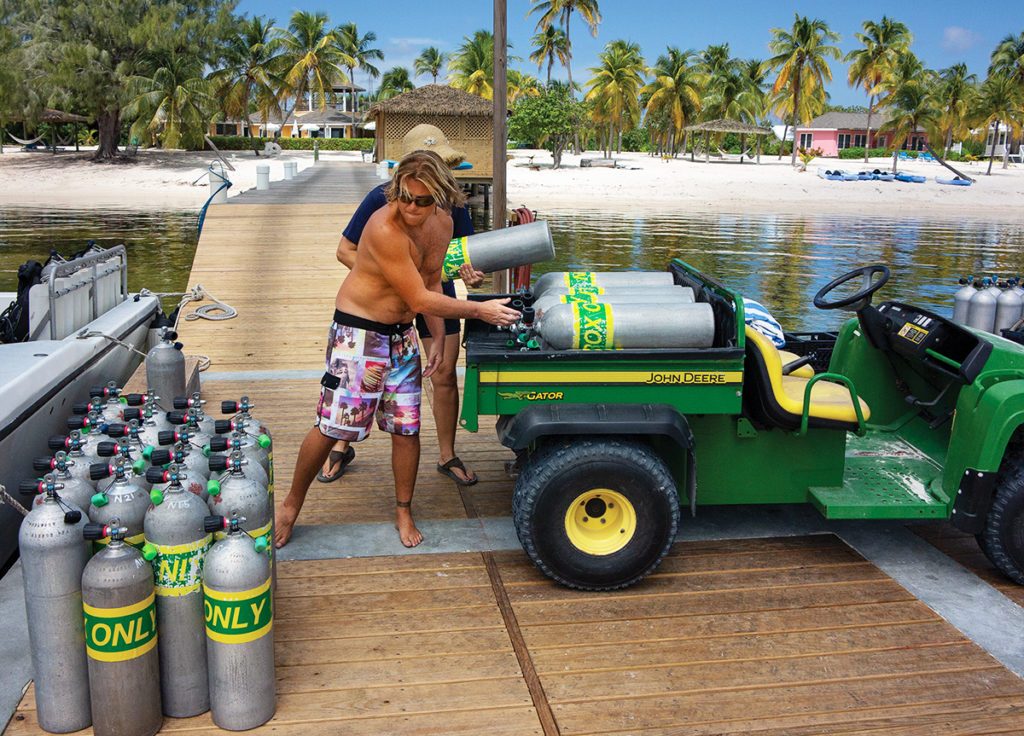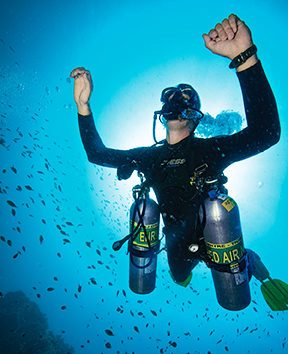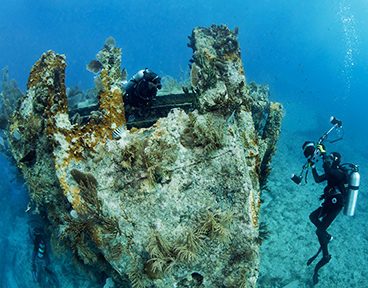THE 11-LITER ALUMINIUM 80, aptly named for its 11-liter internal volume and 80-cubic-foot capacity when filled to its 200 bar/3,000 PSI rated pressure, is by far the most common cylinder. Just because it is the most common, however, may not mean it is the right one for you.
Cylinders come in a wide variety of sizes and materials, and you can set them up in multiple configurations. Choosing the right cylinder for your dive is vital for your enjoyment and safety.
Sizes

The standard aluminum 80 is an economical cylinder that offers an appropriate amount of breathing gas for most divers. Younger or smaller divers, however, may struggle with the size and weight of an aluminum 80 and instead be more comfortable with a shorter cylinder, such as an aluminum 63. Divers who quickly consume gas may benefit from a larger-capacity cylinder, such as an aluminum 100, to extend their bottom time.
When choosing an appropriate cylinder size, consider factors such as the cylinder’s weight, your gas consumption rate, anticipated dive profile, personal comfort, and how much gas your buddy may need if you need to share air in an emergency. If the largest aluminum cylinders don’t provide adequate gas, consider switching to steel cylinders or a setup that allows you to carry multiple cylinders.
Materials
Understanding the differences between steel and aluminum cylinders is important for choosing the right material for your needs. Steel cylinders come in a wide variety of capacities matching those of aluminum cylinders, but some steel cylinders — such as the monstrous steel 130 — can carry significantly more gas than the largest aluminum 100.
Steel cylinders, whether full or empty, tend to be negatively buoyant underwater. Aluminum cylinders often start negatively buoyant but eventually become positively buoyant as a diver consumes the breathing gas. This buoyancy difference means that divers who use steel cylinders do not need as much lead to achieve proper weighting. Although steel cylinders are more negatively buoyant underwater, they have thinner walls than aluminum ones and often weigh about the same, if not less, on land than comparable aluminum cylinders.
The final and perhaps most important consideration is that steel is much more vulnerable to rusting than aluminum. Minor oxidation may occur if moisture gets into an aluminum cylinder, but it is unlikely to cause major damage. Even small amounts of water in a steel cylinder can cause significant rusting and pitting, which can permanently damage the cylinder. Annual visual inspections are crucial for detecting corrosion before it becomes significant and leads to irreversible damage.
Configurations

The single-cylinder configuration we all learned to dive with is sufficient for most dive conditions. If you wish to have redundancy or extra breathing gas, you can add another cylinder to your setup. You can consider a mini bailout bottle with an integrated regulator, but their limited gas volume and the possible lack of an appropriate submersible pressure gauge (SPG) restrict their usefulness. A larger 13- to 80-cubic-foot pony bottle is another option, and you can either strap it to the cylinder on your back or clip it to your buoyancy compensator’s D-rings. With their own first stage, second stage, and SPG, these pony bottles provide a completely redundant system with more breathing gas should the diver encounter an issue. For more information on small bailout cylinders, see Jill Heinerth’s article “Air
and a Spare” from the Q3/Q4 2021 issue of Alert Diver (DAN.org/alert-diver/article/air-and-a-spare).
Back-mounted doubles may be a good alternative if you want a setup where the cylinders are more secure and provide more gas than a single-tank-and-pony configuration. This back-mounted configuration consists of two cylinders with left- and right-handed valves interconnected by a manifold. Each cylinder will have its own first and second stage, a BCD or drysuit inflator hose, and an SPG as necessary. The benefit of this setup is that you have a completely redundant system that rests on your back, similar to carrying a single cylinder. If a regulator or cylinder has a catastrophic failure, the diver can isolate the issue by closing the appropriate valve while still having access to the other cylinder as a gas reserve.

A sidemount configuration may be appropriate if you struggle to carry a heavy set of doubles or find it difficult to squeeze through narrow restrictions in caves or wrecks. With sidemount, you fasten cylinders along your flanks through a system of bungees and bolt snaps. This flexible configuration allows you to quickly identify and resolve any issues because the regulators and valves are easily visible and accessible, unlike with doubles, where valves are located behind the head. Because each cylinder is separate, you need to occasionally swap regulators to maintain a similar pressure in each cylinder. The cylinder positions and flexible attachments can make it difficult to perform a giant stride entry or handle cylinders on a boat, especially in rough conditions. As with all your dive gear, choosing the cylinder material, size, and configuration best suited for the diving you plan to do is essential to your dive safety and enjoyment. If you have any questions, do not hesitate to reach out to the experts at your local dive shop, who can work with you customize a setup that works for you.
